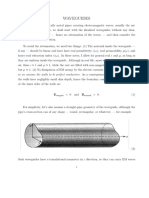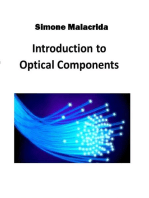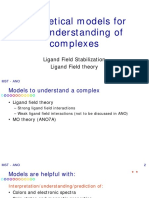Lecture 13: Electron Beams and Applications
Uploaded by
Asad AliLecture 13: Electron Beams and Applications
Uploaded by
Asad AliLecture 13: Electron Beams and Applications
Important applications of electron beam technology includes + X-ray generation + High power microwave generation + Microscopy + Materials modification and processing X-ray generation The basic premise is that x-rays are generated when an electron beam strikes a target. The x-rays then pass through an object and form an image on a piece of film.
x-rays are attenuated, by absorption and scattering, in the target. The parameter describing this attentuation is the linear attentuation coefficient (mu).
The minimum feature size that can be imaged by an x-ray point projection source can be estimated by a simple analysis. Say an incident photon flux N_o [#/(s*cm^2)] falls on a feature of length l, with x-ray mean free path of lambda(E), which is a function of x-ray energy.
The smallest feature, Delta-l, corresponds to the minimum change in photon flux distinguishable from noise, Delta-N. From Poisson statistics, Delta-N ~ sqrt(N).
+ So the minimum resolvable feature size depends on the x-ray mean free path in the material (twice the mfp at a given energy) + the mean free path depends on the linear attenuation coefficient and the total mass attenuation coefficient for the x-ray of a given energy and the object material linear attenuation coeff
total mass attenuation coeff
+ the mean free path is related to the linear attenuation coefficient
+ There is no general expression for these coefficients + The mass attenuation coefficient is high at low energies, falls to a minimum and then rises again at higher energies. + For compounds, the mass attenuation coefficients can be used to combine by weight percentage
+ These values are tabulated for different materials, or can be found in the literature.
+ For high intensity radiography, relativistic electron beam diodes are usually used. + Four common varieties, paraxial, self-pinch, rod-pinch, magnetically immersed.
Paraxial diode
Self-pinched (left) and Rodpinched (right) diodes
Magnetically immersed diodes
All from Maenchen, Proc IEEE v92, n7, 2004.
High Power Microwave Generation The discussion starts with waveguides. + These are ducts that guide waves + Similar to optical fiber (which are also sometimes called waveguide) Maxwell's equations can be reduced to the wave equations. For a vacuum filled region, possibly bounded by conductors or dielectric, we have the following.
We could have three possible solutions, depending on boundary conditions. + Transverse Electromagnetic (TEM) -- E and B vectors are perpendicular to the direction of propagation, k. Get these in free space. Also hollow coax, or parallel plate waveguides, i.e. transmission lines. + Transverse magnetic (TM) -- B is perpendicular to k. Occur in hollow rectangular or circular waveguides. + Transverse electric (TE) -- E is perpendicular to k. Occur in hollow rectangular or circular waveguides. Using a Fourier-Laplace transform, where d/dt -> j(omega), we can write the following.
At a perfect conducting wall, however, the parallel E and perpendicular B must go to zero.
If we assume E and B have wave solutions (equivalent to the Fourier-Laplace transform idea), we will have fields like the following.
Using Maxwell's equations, we can show that + the perpendicular components of E and B (either the r and theta components, or the x and y compoents) can be expressed in terms of the axial field component (consult Humphries or Benford). + if E_z and B_z are both zero (TEM) the transverse components are also zero, and the field in waveguide is trivially zero. Hence no TEM waves in these. Rewriting the wave equations
Assuming separability
v = omega/k > c, always
cutoff: when k=0, or no propagation, omega = omega_co
+ Derived from transverse field boundary conditions + Must have parallel E and perpendicular B equal to zero at the wall + Apply these BCs to the TM or TE wave equations to find the k_perp rectangular waveguide, of x-dimension = a, and y-dimension = b.
for a cylindrical waveguide, of radius rho, B_r=E_theta=E_z=0 at radius rho. Solutions involve Bessel functions of the first kind.
In summary + Waveguides support TM or TE waves, with TM waves having an axial E + Waves come in specific modes, with specific field patterns + Each mode has a cutoff frequency, below which no EM energy can travel in that mode + Each mode travels at a phase velocity > speed of light Slow wave structures + Waveguides confine and conduct EM energy, but at faster than light speeds + If charged particles are to interact with these fields, need to slow down the waves + Slow wave structures slow down EM waves confined within them + Slow EM waves are produced within waveguides with a periodically varying boundary
waveguide
slow wave structure
Some periodic variations include a perturbed wall radius, a periodic array of resonating cavities, or a helical winding within the tube.
Consider a wall with radius that varies periodically
The frequency of normal modes is a periodic function of the wavenumber k_z
The field can be written as a sum, using Floquet's theorem
We can show then,
However, k_perp,m won't correspond to that derived for smooth waveguides, it will be a more complicated function. The end result on the dispersion relation is to make it periodic in k-space. Now sub-c phase velocities are possible.
Microwave generation + Microwaves are generated when space charge waves on a beam interact with normal cavity and waveguide modes + Fast wave interactions occur when the interaction involves a waveguide mode phase velocity faster than light + Slow wave interactions occur when the interaction involves a waveguide mode slower than the speed of light + O-type devices have an electron beam that travels parallel to any externally imposed magnetic field + M-type devices have electron beams traveling perpendicular to crossed electric and magnetic fields + Space charge devices have intense, space charge dominated electron beam interactions
+ We have dealt so far with electron beams that are uniform in the axial direction, or direction of travel. + Imagine a perturbation on the axial beam density
+ This perturbation gives rise to a perturbation in the potential and self-generated electric field along the beam + The perturbation forms a space charge wave that travels along the beam + If the space charge wave phase velocity matches the phase velocity of a normal mode, they can exchange energy -- the perturbation grows, and feeds more energy into the EM normal mode, etc. O-type interactions + The space charge waves on an electron beam also have a dispersion relation
+ The (+) in the dispersion relation gives the fast wave, and the (-) give the slow wave. + Slow space charge waves result in microwave interactions + How do we get a wave with phase velocity below c, to interact with a EM mode? Fill the waveguide with dielectric (dielectric Cerenkov maser)
Use a periodic slow wave structure (backward wave oscillator)
M-type interactions + Electrons move in an ExB drift + interact with an array of cavities + Magnetron
Space charge devices Vircator - an intense electron beam, exceeding the space charge limit enters a grounded gap. Oscillations ensue producing radiation
You might also like
- Guided Waves: - Waveguides - Microstrip - Coaxial LineNo ratings yetGuided Waves: - Waveguides - Microstrip - Coaxial Line32 pages
- Lecture 5 Notes, Electromagnetic Theory II: 1. Waveguides ContinuedNo ratings yetLecture 5 Notes, Electromagnetic Theory II: 1. Waveguides Continued14 pages
- Maxwell's Equations. Electromagnetic WavesNo ratings yetMaxwell's Equations. Electromagnetic Waves15 pages
- Feynman Lectures Simplified 2C: Electromagnetism: in Relativity & in Dense MatterFrom EverandFeynman Lectures Simplified 2C: Electromagnetism: in Relativity & in Dense MatterNo ratings yet
- Maxwell's Eqautions and Some ApplicationsNo ratings yetMaxwell's Eqautions and Some Applications28 pages
- Lecture Notes 5: Electromagnetic Waves in Vacuum The Wave Equation (S) For E and BNo ratings yetLecture Notes 5: Electromagnetic Waves in Vacuum The Wave Equation (S) For E and B33 pages
- Problems in Quantum Mechanics: Third EditionFrom EverandProblems in Quantum Mechanics: Third EditionD. ter Haar3/5 (2)
- Plasma Waves and Instabilities Lecture Notes (Under Development)No ratings yetPlasma Waves and Instabilities Lecture Notes (Under Development)170 pages
- Microwave and Radar Systems: 1. Write A Short Note About Rectangular Waveguides..No ratings yetMicrowave and Radar Systems: 1. Write A Short Note About Rectangular Waveguides..33 pages
- Intensity of Electromagnetic Waves as a Function of Frequency, Source Distance and Aperture AngleFrom EverandIntensity of Electromagnetic Waves as a Function of Frequency, Source Distance and Aperture AngleNo ratings yet
- Lecture 1 Notes, Electromagnetic Theory II: 1. Overview of The CourseNo ratings yetLecture 1 Notes, Electromagnetic Theory II: 1. Overview of The Course20 pages
- 2.57 Nano-to-Macro Transport Processes Fall 2004: Ae Be CeNo ratings yet2.57 Nano-to-Macro Transport Processes Fall 2004: Ae Be Ce7 pages
- Unified Field Theory in a Nutshell1: The Quest for the Theory of EverythingFrom EverandUnified Field Theory in a Nutshell1: The Quest for the Theory of EverythingNo ratings yet
- EEN 330 Electromagnetics I: Dr. M. Bou SanayehNo ratings yetEEN 330 Electromagnetics I: Dr. M. Bou Sanayeh32 pages
- Electromagnetic Waves in Plasma PhysicsNo ratings yetElectromagnetic Waves in Plasma Physics18 pages
- Plane Waves and Wave Propagation: Augustin Jean Fresnel (1788 - 1827) November 9, 2001No ratings yetPlane Waves and Wave Propagation: Augustin Jean Fresnel (1788 - 1827) November 9, 200158 pages
- Optical Fibers: Structures, Waveguiding & FabricationNo ratings yetOptical Fibers: Structures, Waveguiding & Fabrication49 pages
- RF Acceleration in RF Acceleration in Linacs LinacsNo ratings yetRF Acceleration in RF Acceleration in Linacs Linacs32 pages
- Ohmic, Dielectric, and Radiation. The Ohmic Losses Are Caused by The Current Flowing inNo ratings yetOhmic, Dielectric, and Radiation. The Ohmic Losses Are Caused by The Current Flowing in15 pages
- Reminders On Waves: Traveling Waves On A String Obey The Wave EquationNo ratings yetReminders On Waves: Traveling Waves On A String Obey The Wave Equation11 pages
- Optical Fiber and Opto Electronics (Ch-3)No ratings yetOptical Fiber and Opto Electronics (Ch-3)6 pages
- Why Indonesian Coal Is Better in Quality Than Indian CoalNo ratings yetWhy Indonesian Coal Is Better in Quality Than Indian Coal2 pages
- ... Go To Air Volume Calculation Prepared by MD - Zafar ... Go To Strength & Leak Test100% (1)... Go To Air Volume Calculation Prepared by MD - Zafar ... Go To Strength & Leak Test5 pages
- Test Bank For Introduction To Chemistry 5th Edition by Bauer Isbn10 1259911144 Isbn13 9781259911149100% (55)Test Bank For Introduction To Chemistry 5th Edition by Bauer Isbn10 1259911144 Isbn13 978125991114936 pages
- (Overseas-Australia) SDS Meditran S SAE 40 API CF CF2 SF-dikompresiNo ratings yet(Overseas-Australia) SDS Meditran S SAE 40 API CF CF2 SF-dikompresi15 pages
- BS 144 1997 - Specification For Coal Tar Creosote For Wood PreservationNo ratings yetBS 144 1997 - Specification For Coal Tar Creosote For Wood Preservation27 pages
- Irving Langmuir and The Octet Theory of ValenceNo ratings yetIrving Langmuir and The Octet Theory of Valence50 pages
- Effect of Hardness and Wear Resistance On en 353 Steel by Heat TreatmentNo ratings yetEffect of Hardness and Wear Resistance On en 353 Steel by Heat Treatment4 pages
- Theoretical Models For The Understanding of Complexes: Ligand Field Stabilization Ligand Field TheoryNo ratings yetTheoretical Models For The Understanding of Complexes: Ligand Field Stabilization Ligand Field Theory39 pages
- Rd113 The Influence of Casting and Curing Temperature On The Properties of Fresh and Hardened ConcreteNo ratings yetRd113 The Influence of Casting and Curing Temperature On The Properties of Fresh and Hardened Concrete18 pages
- Operating Manual: LKH-110, - 120 Multi-Stage Centrifugal PumpNo ratings yetOperating Manual: LKH-110, - 120 Multi-Stage Centrifugal Pump24 pages
- Aceite Mineral 60 USP - Ficha Tecnica - Lubline - Ingles PDFNo ratings yetAceite Mineral 60 USP - Ficha Tecnica - Lubline - Ingles PDF1 page
- High School Chemistry Research Paper Topics100% (1)High School Chemistry Research Paper Topics4 pages
- Material Science Question and Answer: (Conventional Type)No ratings yetMaterial Science Question and Answer: (Conventional Type)14 pages
- Chemistry Paper - 80 Marks (Study of Compounds, Periodic Table, Chemical Bonding, Mole Concept) Section I (All Questions Are Compulsory)No ratings yetChemistry Paper - 80 Marks (Study of Compounds, Periodic Table, Chemical Bonding, Mole Concept) Section I (All Questions Are Compulsory)4 pages
- A New Approach to the Quantum Theory: Think Physics, #7From EverandA New Approach to the Quantum Theory: Think Physics, #7
- Guided Waves: - Waveguides - Microstrip - Coaxial LineGuided Waves: - Waveguides - Microstrip - Coaxial Line
- Lecture 5 Notes, Electromagnetic Theory II: 1. Waveguides ContinuedLecture 5 Notes, Electromagnetic Theory II: 1. Waveguides Continued
- Feynman Lectures Simplified 2C: Electromagnetism: in Relativity & in Dense MatterFrom EverandFeynman Lectures Simplified 2C: Electromagnetism: in Relativity & in Dense Matter
- Lecture Notes 5: Electromagnetic Waves in Vacuum The Wave Equation (S) For E and BLecture Notes 5: Electromagnetic Waves in Vacuum The Wave Equation (S) For E and B
- Problems in Quantum Mechanics: Third EditionFrom EverandProblems in Quantum Mechanics: Third Edition
- Plasma Waves and Instabilities Lecture Notes (Under Development)Plasma Waves and Instabilities Lecture Notes (Under Development)
- Microwave and Radar Systems: 1. Write A Short Note About Rectangular Waveguides..Microwave and Radar Systems: 1. Write A Short Note About Rectangular Waveguides..
- Intensity of Electromagnetic Waves as a Function of Frequency, Source Distance and Aperture AngleFrom EverandIntensity of Electromagnetic Waves as a Function of Frequency, Source Distance and Aperture Angle
- Lecture 1 Notes, Electromagnetic Theory II: 1. Overview of The CourseLecture 1 Notes, Electromagnetic Theory II: 1. Overview of The Course
- 2.57 Nano-to-Macro Transport Processes Fall 2004: Ae Be Ce2.57 Nano-to-Macro Transport Processes Fall 2004: Ae Be Ce
- Unified Field Theory in a Nutshell1: The Quest for the Theory of EverythingFrom EverandUnified Field Theory in a Nutshell1: The Quest for the Theory of Everything
- Plane Waves and Wave Propagation: Augustin Jean Fresnel (1788 - 1827) November 9, 2001Plane Waves and Wave Propagation: Augustin Jean Fresnel (1788 - 1827) November 9, 2001
- Optical Fibers: Structures, Waveguiding & FabricationOptical Fibers: Structures, Waveguiding & Fabrication
- RF Acceleration in RF Acceleration in Linacs LinacsRF Acceleration in RF Acceleration in Linacs Linacs
- Ohmic, Dielectric, and Radiation. The Ohmic Losses Are Caused by The Current Flowing inOhmic, Dielectric, and Radiation. The Ohmic Losses Are Caused by The Current Flowing in
- Reminders On Waves: Traveling Waves On A String Obey The Wave EquationReminders On Waves: Traveling Waves On A String Obey The Wave Equation
- Why Indonesian Coal Is Better in Quality Than Indian CoalWhy Indonesian Coal Is Better in Quality Than Indian Coal
- ... Go To Air Volume Calculation Prepared by MD - Zafar ... Go To Strength & Leak Test... Go To Air Volume Calculation Prepared by MD - Zafar ... Go To Strength & Leak Test
- Test Bank For Introduction To Chemistry 5th Edition by Bauer Isbn10 1259911144 Isbn13 9781259911149Test Bank For Introduction To Chemistry 5th Edition by Bauer Isbn10 1259911144 Isbn13 9781259911149
- (Overseas-Australia) SDS Meditran S SAE 40 API CF CF2 SF-dikompresi(Overseas-Australia) SDS Meditran S SAE 40 API CF CF2 SF-dikompresi
- BS 144 1997 - Specification For Coal Tar Creosote For Wood PreservationBS 144 1997 - Specification For Coal Tar Creosote For Wood Preservation
- Effect of Hardness and Wear Resistance On en 353 Steel by Heat TreatmentEffect of Hardness and Wear Resistance On en 353 Steel by Heat Treatment
- Theoretical Models For The Understanding of Complexes: Ligand Field Stabilization Ligand Field TheoryTheoretical Models For The Understanding of Complexes: Ligand Field Stabilization Ligand Field Theory
- Rd113 The Influence of Casting and Curing Temperature On The Properties of Fresh and Hardened ConcreteRd113 The Influence of Casting and Curing Temperature On The Properties of Fresh and Hardened Concrete
- Operating Manual: LKH-110, - 120 Multi-Stage Centrifugal PumpOperating Manual: LKH-110, - 120 Multi-Stage Centrifugal Pump
- Aceite Mineral 60 USP - Ficha Tecnica - Lubline - Ingles PDFAceite Mineral 60 USP - Ficha Tecnica - Lubline - Ingles PDF
- Material Science Question and Answer: (Conventional Type)Material Science Question and Answer: (Conventional Type)
- Chemistry Paper - 80 Marks (Study of Compounds, Periodic Table, Chemical Bonding, Mole Concept) Section I (All Questions Are Compulsory)Chemistry Paper - 80 Marks (Study of Compounds, Periodic Table, Chemical Bonding, Mole Concept) Section I (All Questions Are Compulsory)



























































































